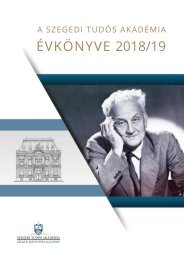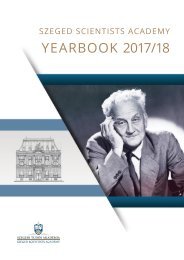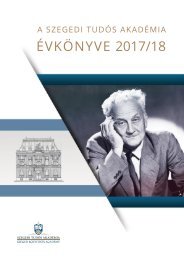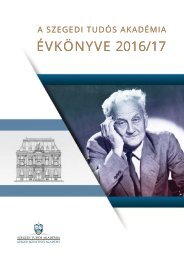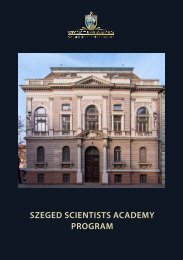SzSA YearBook 2016/17
You also want an ePaper? Increase the reach of your titles
YUMPU automatically turns print PDFs into web optimized ePapers that Google loves.
SZENT-GYÖRGYI JUNIOR MENTORS<br />
ANIKÓ KELLER-PINTÉR<br />
Faculty of Medicine,<br />
Department of Biochemistry,<br />
University of Szeged<br />
Address: Dom tér 9, H-6720 Szeged, Hungary<br />
E: keller.aniko@med.u-szeged.hu<br />
T: +36 62/545-096<br />
RESEARCH AREA<br />
Skeletal muscle is capable of exceptional regeneration following<br />
injury. During the regeneration process, the quiescent<br />
satellite stem cells are activated and form myoblasts<br />
that will subsequently proliferate, differentiate, and then<br />
fuse into multinucleated myotubes. The analysis of signalling<br />
events of muscle regeneration and differentiation has<br />
an important role in developmental biology; and it helps<br />
to reveal the pathomechanisms and therapeutic possibilities<br />
of muscle diseases. Furthermore, it can contribute to<br />
enhance the muscle regeneration following sport injuries.<br />
Skeletal muscle is a highly dynamic tissue; it can change in<br />
size in response to physiological effects, or due to diseases<br />
(e.g. chronic cardiac disease, chronic kidney diseases, or<br />
cancer). Our other research projects focus on the analysis of<br />
the molecular mechanisms influencing muscle adaptation,<br />
regulation of muscle size and metabolism.<br />
TECHNIQUES AVAILABLE IN THE LAB<br />
Mammalian tissue culture techniques, in vivo animal models,<br />
immunohistochemistry, immuno cyto chemistry, fluorescent<br />
microscopy, image analysis, flow cytometry, cell<br />
cycle analysis, cell proliferation assays, spectro photometry<br />
(measurement of enzyme activities, metabolites), PCR, coimmuno<br />
precipitation, GTP-ase activity assays, Western<br />
blot.<br />
SELECTED PUBLICATIONS<br />
Kocsis, T., Trencsenyi, G., Szabo, K., Baán, J.A., Müller, G.,<br />
Mendler, L., Garai, I., Reinauer, H., Deak, F., Dux, L., Keller-<br />
Pintér, A. (20<strong>17</strong>) Myostatin propeptide mutation of the<br />
hypermuscular Compact mice decreases the formation of<br />
myostatin and improves insulin sensitivity. Am J Physiol<br />
Endocrinol Metab 312: E150-E160.<br />
Kocsis, T., Baán, J., Müller, G., Mendler, L., Dux, L., Keller-<br />
Pintér, A. (2014) Skeletal muscle cellularity and glycogen<br />
distribution in the hypermuscular Compact mice. Eur J<br />
Histochem 58: 169-75.<br />
Deák, F., Mátés, L., Korpos, É., Zvara, Á., Szénási, T., Kiricsi,<br />
M., Mendler, L., Keller-Pinter, A., Ózsvári, B., Juhász, H.,<br />
Sorokin, L., Dux, L., Mermod, N., Puskás, L.G., Kiss, I. (2014)<br />
Extracellular matrilin-2 deposition controls the myogenic<br />
program timing during muscle regeneration. J Cell Sci 127:<br />
3240-56.<br />
Baán, J.A., Kocsis, T., Keller-Pintér, A., Müller, G., Zádor,<br />
E., Dux, L., Mendler, L. (2013) The Compact mutation of<br />
myostatin causes a glycolytic shift in the phenotype of fast<br />
skeletal muscles. J Histochem Cytochem 60: 889-900.<br />
Keller-Pinter, A., Bottka, S., Timar, J., Kulka, J., Katona, R.,<br />
Dux, L., Deak, F., Szilak, L. (2010) Syndecan-4 promotes<br />
cytokinesis in a phosphorylation-dependent manner. Cell<br />
Mol Life Sci 67: 1881–94.<br />
83







